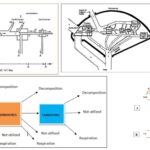Explain briefly the following terms with suitable examples: (i) protonema (ii) antheridium (iii) archegonium (iv) diplontic (v) sporophyll (vi) isogamy
Explain briefly the following terms with suitable examples: (i) protonema (ii) antheridium (iii) archegonium (iv) diplontic (v) sporophyll (vi) isogamy
Please login to submit an answer.
– (i) Protonema: The initial, filamentous, and green stage in the life cycle of mosses, developing from a spore and giving rise to the gametophyte. Example: Moss protonema. – (ii) Antheridium: The male reproductive organ in bryophytes and pteridophytes, producing motile sperm cells. Example: Antheridium in ferns. – (iii) Archegonium: The female reproductive organ in bryophytes, pteridophytes, and gymnosperms, flask-shaped, producing a single egg cell. Example: Archegonium in mosses. – (iv) Diplontic: A life cycle where the diploid sporophyte is the dominant, photosynthetic, and independent phase; gametophyte is reduced. Example: Angiosperms. – (v) Sporophyll: A leaf that bears sporangia; in ferns, these are the fronds with sori. Example: Fern sporophylls. – (vi) Isogamy: A form of sexual reproduction involving gametes of similar morphology (size and shape). Example: Ulothrix exhibits isogamy.
- Share on Facebook
- Share on Twitter
- Share on LinkedIn
Helpful: 0%




